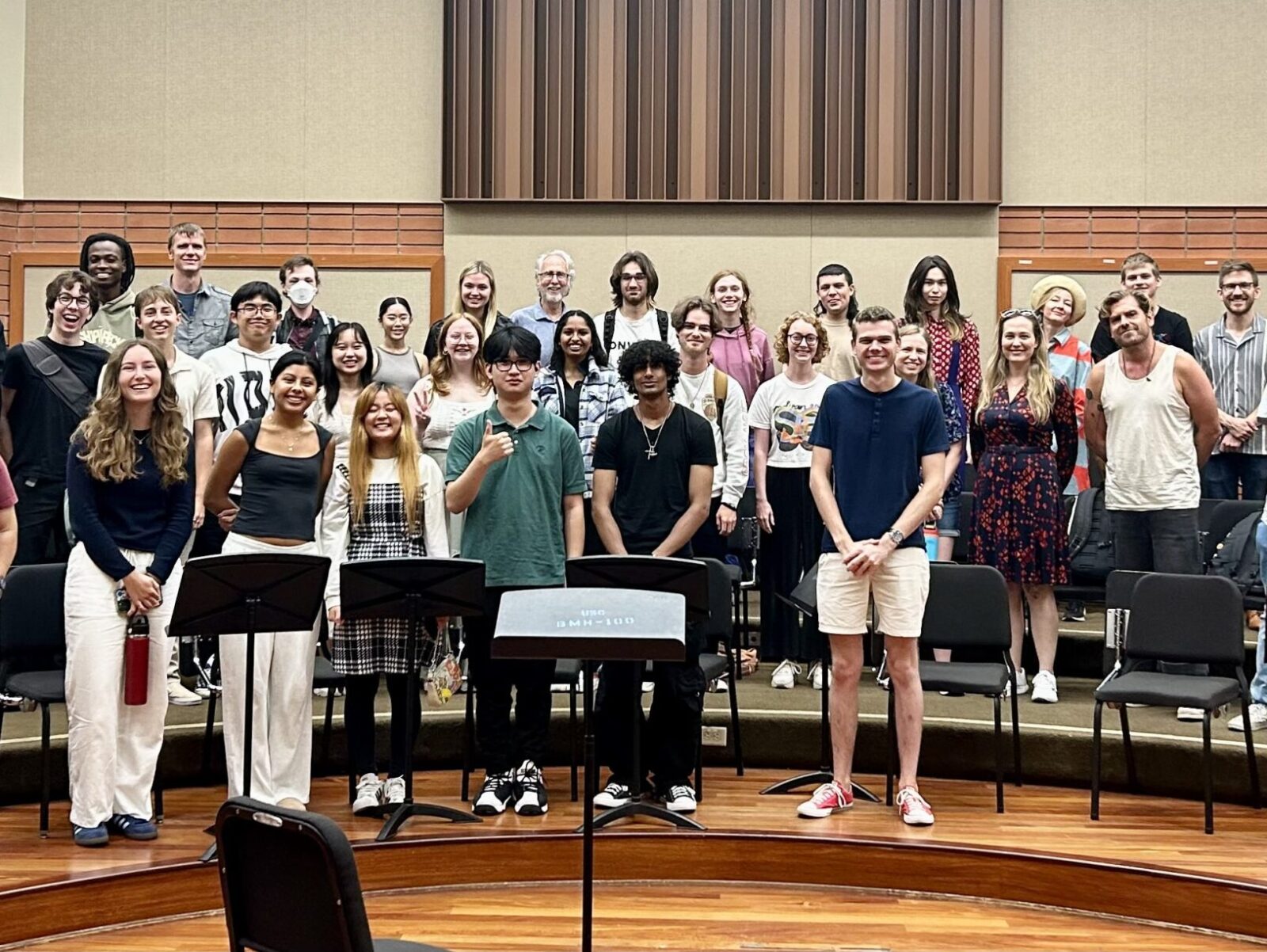The Fisherman’s Post
Madeline Clara Cheng
Having grown up in the Bay Area, I’m no stranger to the ocean. In an intimate storytelling of one of humanity’s oldest trades, Williamson’s text vividly encapsulates the quiet wonder of the sea and its local secrets and folk legends, with marvelous creatures tucked away in the night. Drawing heavily from musical theatre, I was particularly inspired by Dave Malloy’s “No One Else,” another celestial love song. After all, this piece is really just a love song to the passing of knowledge in humanity, the awe of discovery and exploration, and the fascinating world around us.
–Madeline Clara Cheng
pot of gold
Ashlee Sung
why look for a pot of gold at the end of the rainbow? the present moment is already golden, and there’s a rainbow. enjoy it.
–Ashlee Sung
Oasis
Charlie Richardson
This painting is devoid of people.
–Charlie Richardson
Before the Seawall
Ella Kaale
I grew up in Galveston County, Texas and have always been enamored with the folklore of Galveston Island, particularly its ghost stories. The deadliest natural disaster in U.S. history occurred there in 1900: a hurricane resulting in the incalculable loss of ~8,000-12,000 lives. Today, Galveston has a seawall to prevent colossal flooding and a borderline nationalistic pride that its residents can withstand anything. Coastal erosion and sea level rise from the Gulf of Mexico (not America) threaten to swallow the island whole, but Galvestonians insist that if they can survive the Great Storm (1900) and Ike (2008), they can survive anything… This work-in-progress song cycle consists entirely of primary sources from the storm, thus far including (1) an eight-year-old’s written testimony, (2) a hymn sung yearly in honor of the deceased children and nuns of St. Mary’s Orphanage, and (3) a song written by legendary black evangelist Sin-Killer Griffin while serving as a chaplain to convicts in Texas prisons.
–Ella Kaale
mhmmmm REMIXED
Chloe Villamayor
The Remix is still about communication, miscommunication, habits, and connection. Feel free to make what you want of it.
–Chloe Villamayor
Ripple Study I
Benjamin S. Beckman
Ripple Study I is the first in a planned series of pieces exploring rhythmic dilation and contraction. The sonic product reminds me of watching ripples dissipate on a pond surface. In the first part of the study, two groupings of instruments – celesta and glockenspiel, and harpsichord and vibraphone – move through a series of cycles where each group’s material acts independently of the other, though there often happen to be synchronistic features of the music given their concurrence (as if one through stones in two different ponds and watched each pond’s ripple pattern simultaneously). The second part of the study features “ripple chains” in the two groups of instruments, though while each group begins independently, the musical material comes to rest in unison (as if two stones were thrown into the same pond, and one were to watch the ripples effect each other before the pond comes to rest at one moment in time). The third and final part of the study highlights the natural and acoustic phenomenon of constructive interference, where colliding waveforms can cause each to be amplified at the moment of impact.
–Benjamin S. Beckman
Spring in Wartime
Oliviana Marie
“Spring in Wartime” is a poem by Sara Teasdale, written shortly after World War I about the beauty of spring contrasted with the devastation of war. Although I have not lived through a war, my grandfather was a young boy when the Nazis invaded Ukraine and his family spent time in a labor camp in Berlin before coming to America. When news of Russia’s invasion of Ukraine came on the news it upset him very much and I was compelled to write this piece for him.
–Oliviana Marie
Hephaistos
Henryk Golden
Hephaistos is a piece originally intended for a garden statue in a small town in Austria, Mürzzuschlag, depicting the head of Hephaistos, the ancient Greek god of fire and blacksmiths. Reading about the Greek gods one is struck by the contrast of the grandiosity and absurdity, which gives them their allure today. They were worshipped by their followers, yet the stories about them are essentially the same as our folk stories today. Hephaistos’ biggest claim to fame was the use of an axe to split open the head of Zeus, which helped deliver Athena. At least that is one version of the story (all information is from The Gods of the Greek by Karl Kerenyi).
–Henryk Golden
To Hold You Is To Fly
Dylan Dempsey
To Hold You Is To Fly explores the transcendent euphoria that accompanies embracing a loved one – both physically and spiritually. Intertwining tender melodies between the cello and the piano mirror two souls in a gleeful dance as the world falls away and nothing seems impossible.
–Dylan Dempsey
A Dance for Two
Makenna Harding-Davis
This piece, written for Julia Kempf’s A Musical Tribute to Endangered Birds show, is inspired by the waved albatross, a seabird native to the Galapagos Islands. These birds mate for life, and when they are reunited with their partner after a long day of fishing over the open waters, they perform a dance like no other. This dance consists of them snapping their beaks together, almost as if they were fencing, and ends with a long, mournful call. I used this dance as inspiration for my piece, which celebrates the beauty of this critically endangered species.
–Makenna Harding-Davis
Selections from Seven Marginalia for String Quartet
Olivia Marckx
Marginalia are notes and drawings made in the margins of medieval manuscripts. These musical “doodles” contain the structure of standard quartets, but are condensed in order to maximize their unique characters.
–Olivia Marckx

